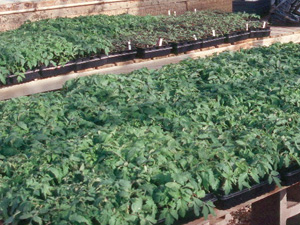
Five week old tomato seedlings are ready for transplant (Photo Courtesy of Lewis Jett)
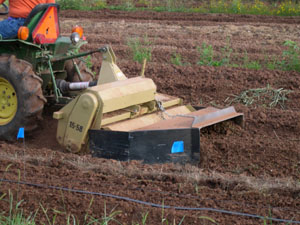
A bed shaper pulls soil into a raised bed creating a uniform planting surface (Photo courtesy of Kim Williams)
When to Plant
- In general, 4-5 week old tomato seedlings can be transplanted into the high tunnel 4-5 weeks earlier in the season than they could be transplanted into the field
- When soil temperatures inside the high tunnel reach 60°F at 2″ depth, it is safe to transplant
- For tomato production earliest in the season, row covers, raised beds, drip irrigation, plastic mulch and/or a portable back-up heater may be necessary
- Field Production Comparison: Transplant in field after chance of frost has past. For example, in northeast Kansas, the frost free date is May 9, although killing frosts do not typically occur after April 18
Using Raised Beds & Mulches
- Raised beds enhance soil warming, drainage, and volume of soil for the root system
- Raised beds should be 6-10″ high and 24-30″ wide
- Four foot spacing between raised beds allows five rows in a 20′ wide high tunnel
- Raised beds can be formed with compact bed shapers or power tillers
- After the beds are formed, fertilizer, drip tape, and mulch can be applied.
- For early season tomato production, black, clear orIRT (infrared transmitting) mulch can be applied to raise soil temperatures, reduce weed emergence, and minimize water evaporation from the soil surface
- Clear plastic will result in significantly higher soil temperatures than black plastic, however, weeds can germinate and emerge under the clear film
- Organicmulches such as straw, hay or compost can also be used for tomato production in high tunnels
- Some organic mulches can actually result in lower soil temperatures than bare soil, so these mulches should be applied after soil temperatures have increased
- Field Production Comparison: Tomatoes benefit from raised beds and use of mulch in the field as well. Larger machinery can be used to form raised beds and lay tape and mulch
Plant Spacing
- Depending on the width and length of the high tunnel plant spacing may vary; however, allowing 4 to 6 square feet per plant is recommended
- A typical spacing is 18-24″ within rows and 4′ between rows. In a 20′ X 96′ high tunnel, this spacing would accommodate approximately 300 tomato plants
- Field Production Comparison: In general, tomatoes grown in the field are spaced 18-24″ within rows and 5-6′ between rows to facilitate movement of machinery
Row Covers
-
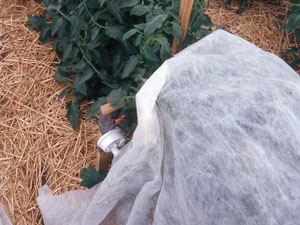
Single layer of Row Covers cover tomato plants in Columbia, Missouri (Photo Courtesy of Lewis Jett)
Row covers are lightweight, spun bonded polypropylene “blankets” that are usually supported over the crop row with wire hoops
- Row covers are permeable to light, water, and air but retain the warmth of the soil after it has been heated by solar radiation
- Row covers may come in different thickness or weights
- Row covers are an important component of successful high tunnel tomato production, their use significantly increases the average daily temperature of crops grown under them
- Use of row covers generally results in an additional 2-8° F of warmth compared to outside temperatures
- Tomato transplants that are properly hardened off can withstand outside temperatures as low as 20°F under the double protection of a row cover inside a high tunnel
- Row covers can be kept on the tomato plants from transplant to the appearance of the first flower clusters
- Field Production Comparison: Strong wind currents can blow the row covers off, and lighter winds can dissipate trapped thermal energy that is insulating the plant
- In the field environment, a medium-weight row cover will increase the air temperature around the plants by several degrees
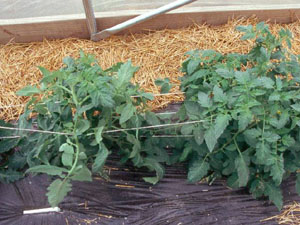
Tomato plants supported by parallel strings (Photo Courtesy of Lewis Jett)
Crop Support & Pruning
- Crop support is important during production of tomatoes to improve light interception, reduce disease incidence, and enhance early fruit set
- The most effective crop support method is the stake and weave system, but cages may also be used
- Pruning tomatoes refers to the removal of axillary shoots which are commonly called suckers
- Remove suckers less than 4″ long up to the one below the first flower cluster
- Removal of these suckers will not increase yield, but will promote early harvest
- Field Production Comparison: Support systems, which include cages, wire trellises, individual stakes and stake and weave systems, are all recommended for use during field production depending on cultivar and management practices. Depending on the extent of field production, pruning is sometimes too labor intensive to be beneficial or cost effective
Watering
- Because high tunnels prevent rainfall from reaching the plants, tomatoes must be provided with a consistent, high quality water supply
- Drip tape is the preferred irrigation method as it allows uniform application of water that contributes to improved yield and quality
For more on Water Supply go to: Planning & Construction
Tomatoes require large volumes of water, especially as the fruit is developing; the fruit is 95% water- From fruit set to harvest, 1-3 quarts of water per plant per day may be required
- For example, a high tunnel with 320 plants could require up to 1,100 gallons of water per week
- In general, the soil moisture tension for tomatoes should be maintained between 10 and 20 centibars (cb). When measured with a tensiometer, soil moisture tension exceeds 20 cb, irrigation should occur
- Field Production Comparison: The best yield occurs with a consistent water supply throughout the growing season and drip irrigation is often the easiest method to accomplish uniform irrigation; however, natural rainfall can meet some or all of the water requirements of the crop during field production
Fertilization
- At transplant, a soluble starter fertilizer that is high in phosphorus is recommended (e.g. 9-45-15)•Nitrogen
requirements vary based on soil test results- If required nitrogen can be applied via the drip system two weeks after transplant at a rate of 8-10 lbs/acre
- Field Production Comparison: 30-40 lbs/acre nitrogen may be added pre-plant with an additional 30-50 lbs/acre added as a side dress or through fertigation. In addition, about 1 cup of starter fertilizer that is high in phosphate is recommended per plant at transplant
Harvest
- Tomatoes can be harvested at various stages of ripeness
- Fresh market tomatoes are harvested at stages ranging from light red to full red, which is also known as vine-ripe
- Vine-ripe tomatoes are harvested approximately 2 times per week
- Yield per tomato plant grown in a high tunnel are up to 25 lbs/plant
- Tomatoes sold in the wholesale market are sorted by size and packed in standard boxes or cartons that hold 15-25 lbs each
- The size refers to the number of tomato fruit that will fit into a standard carton: for example, 5X5 tells the buyer that 5 rows of 5 tomatoes are in each layer.
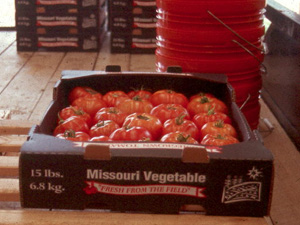
Tomato boxed and ready for shipment (Photo Courtesy of Lewis Jett)
This indicates count per box and relative size of the fruit
Name Fruit Size Designation Size Minimum Inches Maximum Inches Maximum Large 4×5 3 15/32 larger Extra Large 5×5 & 5×6 2 28/32 3 15/32 Large 6×6 2 17/32 2 28/32 Medium 6×7 2 9/32 2 17/32 Small 7×7 2 4/32 2 9/32 Extra Small 7×8 1 28/32 2 4/32 - The size refers to the number of tomato fruit that will fit into a standard carton: for example, 5X5 tells the buyer that 5 rows of 5 tomatoes are in each layer.
Field Production Comparison: Harvest stages and grading practices are the same regardless of cultural practices used. In Northeast Kansas an early May transplant date would produce an early July through early October harvest period with yields ranging from 10-20 lbs/plant




